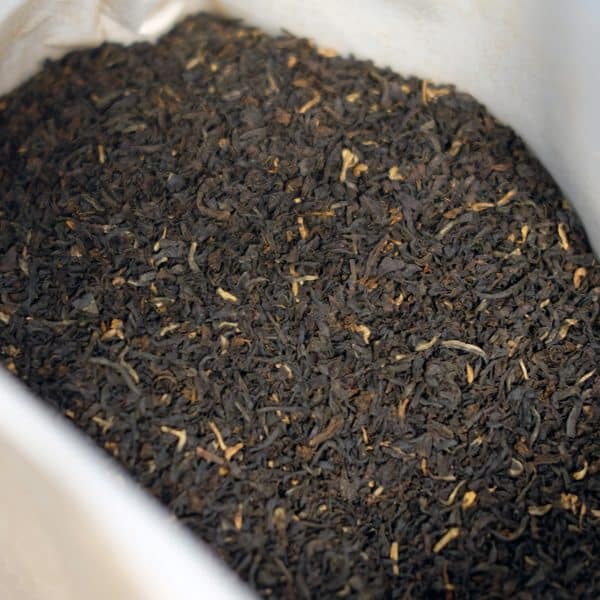Description
This Darjeeling tea from India comes from the Margret’s Hope estate, one of the most famous and oldest plantations in India. Mr. Bagdon – the British owner of the plantation – had a daughter who once visited the plantation and instantly fell in love with its stunning landscape. She promised to return soon, but tragically died on the ship on the way home. Consequently, in 1930, Mr. Bagdon renamed the estate Margaret’s Hope.
Although Darjeeling tea comes from India, it is the Chinese tea plants, the Camellia Sinensis, that grow here. The slow growth of the plants ensures excellent quality and a full aroma. This version comes from the second flush, the summer harvest in May and June, and falls under the black tea class.
It is a Tippy Golden Flowery Orange Pekoe First Grade Leaves (TGFOP1). This classification is based on the size and quality of the tea leaves, with TGFOP1 being one of the highest possible leaf classifications.
A delightful, soft black tea with a full aroma and a spicy, slightly sweet undertone.
Margret’s Hope Tea Estate
Margaret’s Hope tea estate is situated in the northern valley of Kurseong, the land of the white orchid, in Darjeeling, near the Longview Highlands. The plantation is located at an altitude ranging from 106 meters to 1800 meters, covering an area of about 361 hectares. Due to its high elevation and consequent cooler temperatures, the tea is produced much later compared to other Darjeeling tea gardens. Two rivers also flow through the plantation area. The tea garden was first established in 1830, but only became profitable in 1864. Before the name change in honor of Mr. Bagdon’s daughter, the estate was known as Bara Ringtong.
The estate produces some of the best black, green, and white Darjeeling teas. The teas from this estate have a particularly robust and fruity character, partly due to the many Chinese tea bushes that grow there.
Darjeeling Tea
Darjeeling is a region in the Indian state of West Bengal, primarily producing black tea. It is a small, cold, and high-altitude region, characterized by slow-growing and difficult-to-harvest tea plants. In a good year, production amounts to about 9 million kg, accounting for one percent of all tea produced in India. Yet, this is undoubtedly India’s most famous tea variety with a unique flavor that cannot be replicated anywhere else in the world.
Darjeeling tea grows on steep slopes, at altitudes from 550 to 2000 meters, providing natural drainage for the abundant rainfall. The higher the plant is situated, the thinner the body of the tea and the more concentrated the flavor. However, altitude is only one factor determining Darjeeling’s quality. The varying clouds and sunshine playing over the slopes also contribute, as do the soil chemistry, temperature, wind, and precipitation, which are unique to the area.
An additional explanation for the unique character of Darjeeling is the many Chinese tea plants that grow there. These are almost not found outside of China (and Japan). These plants are more resilient to cold than the native Indian Assam tea plants, but their yield is much lower. The Chinese tea plant has a small, leathery leaf with a dark, glossy green color and is often covered with a silvery down.
During the growing season, every tea bush is hand-picked every 4 to 8 days, as the young, tender shoots must be harvested timely. A typical plant yields only 100 grams of tea per year. All Darjeeling tea is processed according to the traditional, Orthodox black tea production method.
There are about 90 different tea plantations throughout Darjeeling. In the 1990s, some plantations also began producing small quantities of promising white, green, and oolong teas.
First, Second, and Autumn Flush
After a period of rest in the winter months, the tea plants of Darjeeling awaken in early March and begin the first new growth or “flush” of the year, delicate slender shoots with a glossy gray-green appearance. The first flush season lasts until early May. The tea acquires its unique taste thanks to intense sunshine paired with the cold Himalayan air of early spring. These growing conditions make First Flush Darjeeling a young tea that is almost as light as green tea but very aromatic. First flush tea, also known as spring teas or ‘Spring Teas’, is always amazingly fresh with a floral flavor.
From May, the famous Darjeeling summer teas are produced. The Second Flush tea leaves have a purplish bloom or gloss, often also with silver leaf buds. The tea itself has more color and tastes lusher and softer compared to a spring Darjeeling. Second Flush Darjeeling is a special, complex black tea with a lingering aftertaste and is characterized by more fruit, a fuller body, and a richer aroma than First Flush. The Second Flush season lasts until the rains from the south arrive.
In October, the weather clears, and the season of the Autumnal Flush begins, extending until November when the air cools, and the sunshine slowly disappears. This autumn tea is light copper brown in color with a delicate, sparkling quality and a completely different taste than that of spring and summer tea.
Ingredients
Black tea from India

















Reviews
There are no reviews yet.